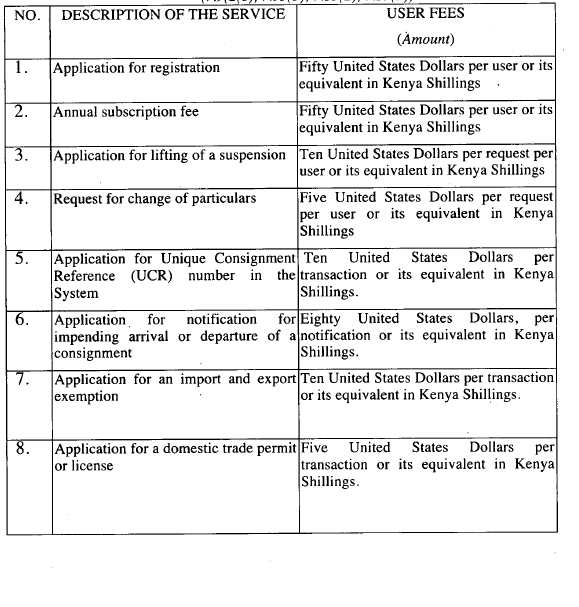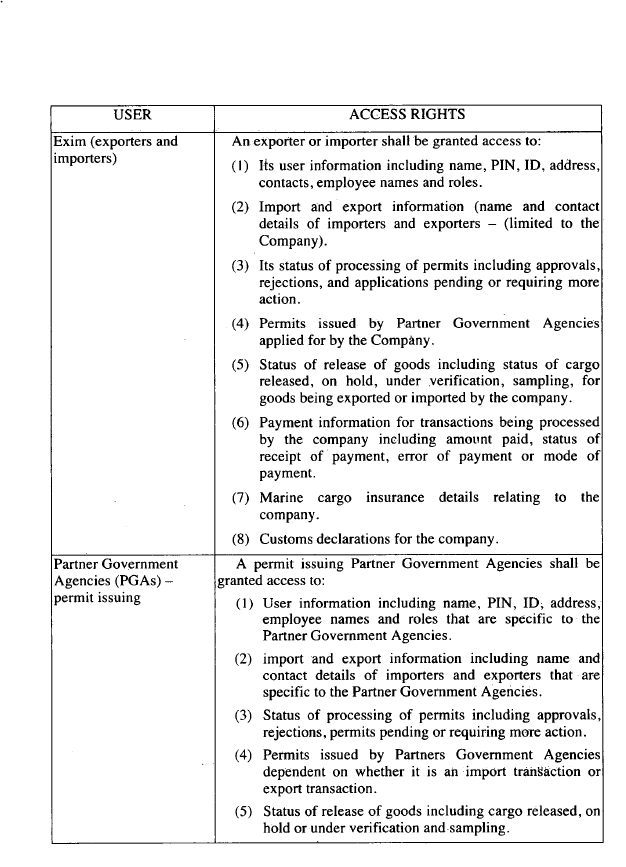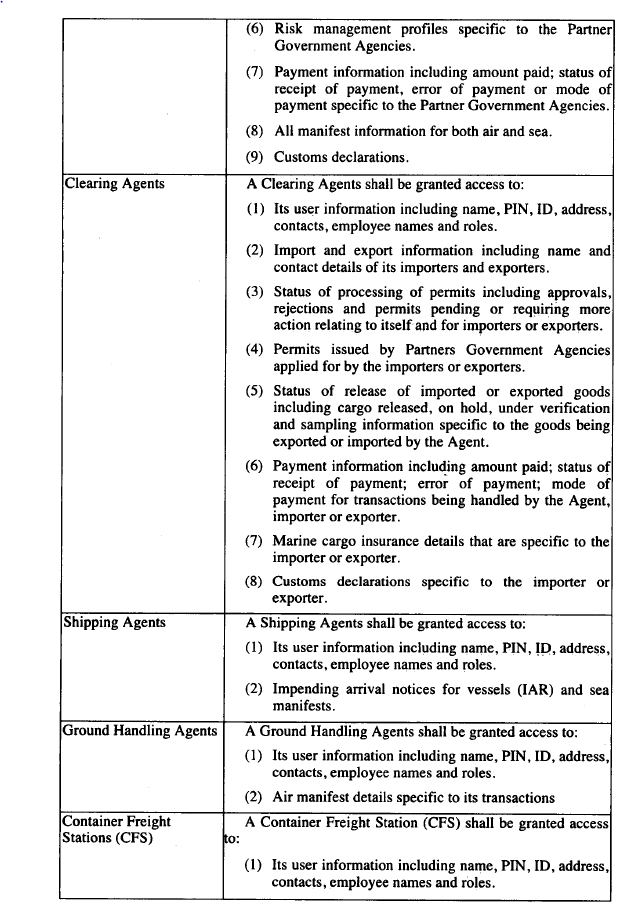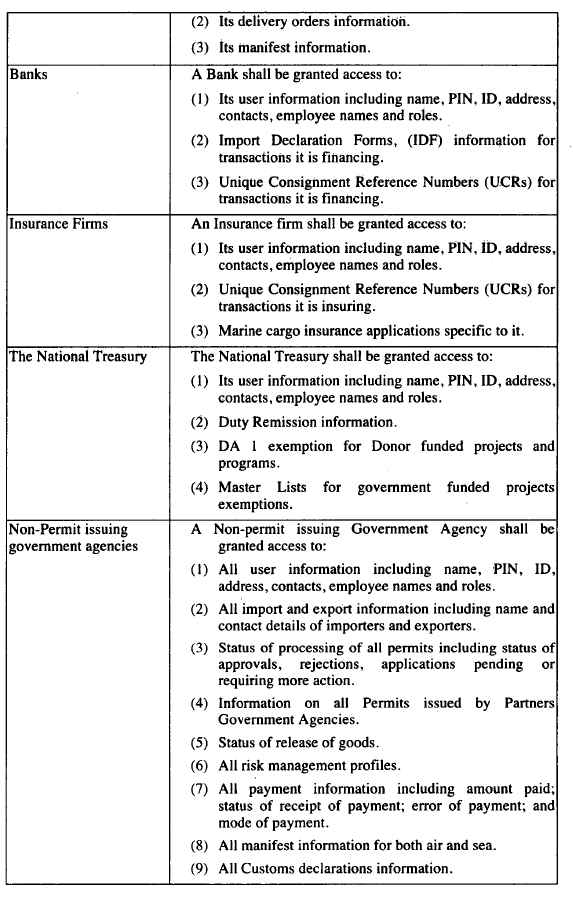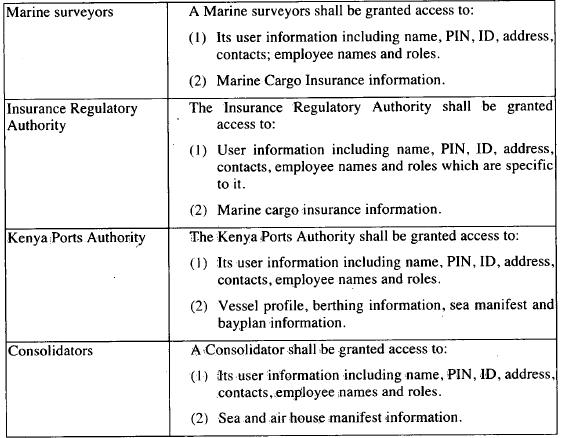|
|
THE NATIONAL ELECTRONIC SINGLE WINDOW SYSTEM (GENERAL) REGULATIONS, 2023
ARRANGEMENT OF REGULATIONS
| 3. |
Objects and purpose of Regulations
|
PART II – FEATURES OF THE SYSTEM
| 4. |
Function of the System
|
| 5. |
Capabilities of the System
|
| 6. |
Components of the System
|
| 8. |
Service level agreement
|
PART III – REGISTRATION OF USERS
| 9. |
Application for Registration
|
| 11. |
Rejection of an application
|
| 12. |
Notification of login credentials
|
| 15. |
Lifting of suspension
|
| 16. |
Deregistration of a user
|
PART IV – ACCESS TO THE SYSTEM
| 17. |
Access by a user into the System
|
| 18. |
Responsibilities of a user
|
| 19. |
Applications in the System
|
PART V – TRADE FACILITATION MECHANISM
| 20. |
Onboarding and integrating into the System
|
| 21. |
Database of imported and exported goods
|
| 22. |
Simplified procedures
|
| 23. |
Portal on trade information
|
| 24. |
National Logistic Platform
|
| 25. |
Facilitation services
|
| 26. |
Support to County governments
|
| 27. |
Protection of the economy
|
| 28. |
Public health, safety and environment
|
| 29. |
Facilitation of applications under other laws
|
PART VI – MISCELLANOUS PROVISIONS
| 30. |
Trade statistics report
|
| 32. |
Application of the Data Protection Act (Cap. 411C)
|
SCHEDULES
| FIRST SCHEDULE [r. 9(2)(a)(i)] — |
FORMS
|
| SECOND SCHEDULE [r. 9(2)(c), r. 13(3),r.15(2); r. 19(2)] — |
FEES
|
| THIRD SCHEDULE [r. 13(1), r. 17(2)] — |
LEVELS OF ACCESS BY USERS
|
THE NATIONAL ELECTRONIC SINGLE WINDOW SYSTEM (GENERAL) REGULATIONS, 2023
| 1. |
Citation
These Regulations may be cited as the National Electronic Single Window System (General) Regulations, 2023.
|
| 2. |
Interpretation
In these Regulations, unless the context otherwise requires—
"Act" means the National Electronic Single Window System Act, (Cap. 285D);
"clearance document" means an official document that an importer or exporter is required to obtain in order to be cleared by a relevant regulatory agency;
"logistics platform" means the National Logistics Platform established under regulation 24;
"Register" means the electronic register of registered users maintained in accordance with regulation 13;
"service-level agreement" has the meaning assigned to it under section 2 of the Act;
"System" has the meaning assigned to it under section 2 of the Act;
"user" means a person registered and authorised by the Agency to use the system.
|
| 3. |
Objects and purpose of Regulations
The objects and purpose of these Regulations is to give effect to section 43(1) of the Act and to—
| (a) |
facilitate the efficient administration of the System;
|
| (b) |
provide for registration of the users of the System;
|
| (c) |
enable the single-entry point for submission and receipt of cargo clearance documents or any other relevant information;
|
| (d) |
set out the methods for integrating or on boarding a stakeholder into the System;
|
| (e) |
provide mechanisms for the System to serve the entire trade and logistics within airports, seaports and dry ports; and
|
| (f) |
facilitate the electronic payment of fees and levies on permits and licenses for imported or exported goods.
|
|
PART II – FEATURES OF THE SYSTEM
| 4. |
Function of the System
The System shall provide a logistics platform to—
| (a) |
make an electronic application for—
| (i) |
a unique consignment reference; |
| (ii) |
implementing arrival and departure reported for a vessel; |
| (iii) |
an import and export permit license or exemption; |
| (iv) |
marine cargo insurance; or |
| (v) |
a domestic trade permit or licence; |
|
| (b) |
issue, send or serve a notifcation for status of the processing of an application;
|
| (c) |
receive imports and exports declarations from the Commissioner of customs or Partner States;
|
| (d) |
make, vary, or cancel any entry for a permit, licence or any other relevant document lodged into the System;
|
| (e) |
lodge an objection to any transaction in the System;
|
| (f) |
give a statement of reasons for an action taken through the System; and
|
| (g) |
make an electronic payment of fees and levies for purposes of the Act.
|
|
| 5. |
Capabilities of the System
The System shall have capabilities to—
| (a) |
enable a user to execute the transactions in the System;
|
| (b) |
integrate various payment system methods for payment of fees and levies;
|
| (c) |
facilitate configuration of risks associated with a transaction; and
|
| (d) |
enable a user to apply and process regulatory requirements for domestic trade.
|
|
| 6. |
Components of the System
| (1) |
The System shall consist of—
| (c) |
technology infrastructure; and
|
|
| (2) |
In operating the System, the Agency shall apply open standards that enable technical interoperability among different involved platforms.
|
|
| 7. |
System maintenance
| (1) |
The Agency shall undertake routine and scheduled maintenance of the System to make the system available, accessible and usable.
|
| (2) |
Where the Agency identifies the need for scheduled maintenance that is likely to cause disruptions to the System’s availability, the Agency shall issue notice of at least forty-eight hours prior to carrying out of the maintenance.
|
| (3) |
Despite the notice period under paragraph (2), the Agency may perform emergency maintenance where necessary to maintain the integrity and security of the System.
|
|
| 8. |
Service level agreement
| (1) |
The Agency shall enter into a service-level agreement with an entity authorised to provide services through the System in accordance with section 9(a) of the Act.
|
| (2) |
A service-level agreement under paragraph (1) shall—
| (a) |
specify the obligations of each party to the agreement;
|
| (b) |
identify the systems that are subject to integration and clearly define their boundaries;
|
| (c) |
clarify the levels of confidentiality for information classification;
|
| (d) |
provide for levels of authorisation and access controls;
|
| (e) |
establish the criteria for the data management life-cycle including the retention period;
|
| (f) |
establish limitations and liability coverage for exposure; and
|
| (g) |
specify any other relevant information.
|
|
|
PART III – REGISTRATION OF USERS
| 9. |
Application for Registration
| (1) |
Pursuant to section 12 of the Act, a person seeking to use the System shall apply to the Agency for registration as a user of the System.
|
| (2) |
An application for registration under paragraph (1) shall be—
| (a) |
| (i) |
KTNA 1 set out in the First Schedule, where the applicant is a non-governmental agency; or |
| (ii) |
KTNA 2 set out in the First Schedule, where the applicant is a partner government agency. |
|
| (b) |
| (i) |
registration certificate of the business entity or an identity document of an individual; |
| (ii) |
evidence of registration as a tax payer from the relevant tax authority; |
| (iii) |
evidence of registration by the relevant regulatory authority where the applicant is a regulated entity; and |
|
| (c) |
accompanied by the registration fees set out in the Second Schedule.
|
|
| (3) |
Upon receipt of an application under this regulation, the Agency may—
| (a) |
upon confirming that the applicant meets the conditions for registration, approve the application for registration and enrol the applicant in a training course on the use of the System; or
|
| (b) |
reject the application on any of the ground specified under regulation 11 and notify the applicant of the decision.
|
|
|
| 10. |
Registration of user
The Agency shall register a successful applicant as a user of the System upon the successful completion of the training stipulated in regulation 9(3).
|
| 11. |
Rejection of an application
| (1) |
The Agency may reject an application for registration where an applicant fails to—
| (a) |
provide the required evidence or documents;
|
| (b) |
meet the registration criteria or conditions;
|
| (c) |
undertake the training required under regulation 9(3); or
|
| (d) |
pay the specified registration.
|
|
| (2) |
Where an application for registration is rejected, the Agency shall, within seven days of the decision, notify the applicant of the decision indicating reasons thereof.
|
|
| 12. |
Notification of login credentials
The Agency shall notify a registered user of their System login credentials within forty-eight hours of registration.
|
| 13. |
Register of users
| (1) |
Pursuant to section 12(3)(b) of the Act, the Agency shall keep and maintain an electronic register of all users registered in accordance with the Act and these Regulations.
|
| (2) |
The Register shall contain the following particulars of users —
| (b) |
the physical address of the user;
|
| (c) |
the phone number and e-mail address of the user;
|
| (d) |
the levels of access of the user as specified in the Third Schedule; and
|
| (e) |
any other relevant information.
|
|
| (2) |
Where a user changes any of their particulars, the user shall notify the Agency of the change by seeking an update of the record in the Register.
|
| (3) |
A request under paragraph (2) shall be made Form KTNA 3 set out under the First Schedule and accompanied by the fee specified in the Second Schedule.
|
| (4) |
Within seven days of receipt of the request under paragraph (3), the Agency shall verify the users request and update the Register.
|
|
| 14. |
Suspension of a user
| (1) |
The Agency may suspend a user’s access to the System where—
| (a) |
the user’s account is dormant for at least six months;
|
| (b) |
the user contravenes a directive issued by the Agency on the use of the System; or
|
| (c) |
the user fails to cooperate with the Agency on any inquiry related to the use of the System.
|
|
| (2) |
Before executing a suspension under paragraph (1), the Agency shall issue a notification to the user specifying the reasons for the suspension and the effective date.
|
|
| 15. |
Lifting of suspension
| (1) |
A user whose access to the System has been suspended under regulation 14 may apply to the Agency to lift the suspension and allow the user to re-access the System.
|
| (2) |
An application under paragraph (1) shall be made in form KTNA 3 set out in the First Schedule accompanied by fees set out in the Second Schedule.
|
| (3) |
Upon receipt of an application under paragraph (2), the Agency shall consider the application and may—
| (a) |
approve the application and reinstate the user’s access to the System and notify the user within forty-eight hours of making the decision; or
|
| (b) |
reject the application and, within seven days of making the determination, notify the applicant of the decision indicating the reasons thereof.
|
|
|
| 16. |
Deregistration of a user
In addition to conditions specified under section 12(4)(b) of the Act, the Agency may deregister a user who—
| (a) |
improperly accesses or interferes with the System;
|
| (b) |
provides false or misleading information in the application for registration;
|
| (c) |
fails to comply with the conditions issued after receiving a notice of suspension under regulation 14;
|
| (d) |
requests for deregistration from the System;
|
| (e) |
has been barred by a court of competent jurisdiction from using the System;
|
| (f) |
has been blacklisted or has had their operational licences revoked by a relevant regulatory authority; or
|
| (g) |
has been convicted of a criminal offence.
|
| (2) |
Prior to effecting the deregistration of a user, the Agency shall issue a notification to a user specifying the grounds and the effective date of deregistration.
|
| (3) |
A user who has been deregistered under this regulation shall have the right to reply to the notice offering any justification against the deregistration.
|
| (4) |
Upon deregistration of a user under this regulation, the Agency—
| (a) |
shall terminate the users access to the System including all associated rights, privileges and authorizations; and
|
| (b) |
may reject, cancel or proceed with any pending transaction initiated by a deregistered user as deemed necessary.
|
|
| (5) |
A user dissatisfied with the Agency’s decision under this regulation may lodge a complaint in accordance with regulation 31.
|
|
PART IV – ACCESS TO THE SYSTEM
| 17. |
Access by a user into the System
| (1) |
A user shall use the System to—
| (a) |
apply for and process a permit or any other export, import or transit document;
|
| (b) |
apply for and process any document required for domestic trade transaction; or
|
| (c) |
access a transaction lodged into the System using their account.
|
|
| (2) |
The levels of access to the System granted to a user shall be in accordance with the access criteria specified in the Third Schedule.
|
| (3) |
Every user shall comply with the administrative terms and conditions on the use of the System as may be specified by the Agency.
|
|
| 18. |
Responsibilities of a user
| (a) |
be responsible for the transactions processed through the system using their account;
|
| (b) |
not disclose or share their account login credentials;
|
| (c) |
maintain, at their own cost, adequate hardware, software and internet connectivity to access the System; and
|
| (d) |
protect the confidentiality of their transaction carried out in the System.
|
|
| 19. |
Applications in the System
| (1) |
A user shall access the System to lodge an application for—
| (a) |
a unique consignment reference;
|
| (b) |
impending arrival and departure reports for a vessel;
|
| (c) |
an import or export exemption; or
|
| (d) |
a domestic trade permit or licence.
|
|
| (2) |
A user who lodges an application under paragraph (1) shall pay the respective fees as set out under the Second schedule.
|
|
PART V – TRADE FACILITATION MECHANISM
| 20. |
Onboarding and integrating into the System
| (1) |
Where an entity seeks to on-board or integrate into the system, the entity shall submit a written request to the Agency.
|
| (2) |
Upon the receipt of the request to be on boarded or integrated, the Agency shall initiate engagements with the requested entity.
|
| (3) |
Once a decision to on-board or integrate into the System is agreed upon, the Agency and the requesting entity shall jointly conduct a feasibility study and develop business and systems requirements.
|
| (4) |
Unless otherwise agreed, the cost of integration or on-boarding shall be met by the requesting entity.
|
| (5) |
The integration or on-boarding shall be implemented in accordance with the agreed upon business and system requirements between the Agency and the requesting entity.
|
| (6) |
When the integration or the on-boarding process is completed, the Agency and the requesting entity shall notify and sensitize the affected shareholders.
|
|
| 21. |
Database of imported and exported goods
| (1) |
The Agency shall establish and maintain a database of imported and exported goods to facilitate trade operations.
|
| (2) |
The database established under paragraph (1) shall contain—
| (a) |
a description of the goods;
|
| (b) |
the particulars of an importer and exporter;
|
| (e) |
the terms of the transaction;
|
| (f) |
the harmonised System Codes;
|
| (g) |
the details of the country of origin;
|
| (h) |
the details of the country of export or supply; and
|
| (i) |
any other relevant information.
|
|
| (3) |
Any access to the database shall be limited to the authorised personnel or on request.
|
|
| 22. |
Simplified procedures
| (1) |
In the furtherance of the objectives of the System under section 7, the Agency shall put in place measures to streamline trade transactions in the System which shall include—
| (a) |
reduction in the number of documents or data entries required for trade transactions;
|
| (b) |
reduction of the time taken to clear the goods;
|
| (c) |
reduction of physical inspection and examination;
|
| (d) |
the automation of trade processes to reduce manual intervention and improve efficiency; and
|
| (e) |
the use of electronic signatures to authenticate transactions.
|
|
| (2) |
Without prejudice to subsection (1), the Agency shall consult and collaborate with relevant regulatory agencies and stakeholders on simplifying of import and export procedures in order to —
| (a) |
identify challenges and inefficiencies in the logistical process in the import, export and transit; and
|
| (b) |
develop simplified procedures that reduce the time and costs associated with the logistical process of trade transactions.
|
|
| (3) |
The simplified procedures identified under paragraph (2) shall be subjected to the approval of the Agency and the relevant regulatory body before implementation.
|
| (4) |
Upon adoption of simplified procedures develop under this regulation, the Agency shall create awareness and sensitize the relevant stakeholders of the simplified procedures.
|
|
| 23. |
Portal on trade information
| (1) |
The Agency shall establish a portal to provide to information on import, export and transit procedures.
|
| (2) |
The Agency shall engage the relevant regulatory agency to obtain information on imports, exports and transit procedures.
|
| (3) |
Subject to paragraph (2), the respective regulatory body shall approve the procedures before the Agency publishes them on the portal.
|
|
| 24. |
National Logistic Platform
| (1) |
Pursuant to section 43(2)(d) of the Act, there shall be a platform to be known as the National Logistics Platform.
|
| (2) |
The logistics platform may be used by the Agency to promote efficient trade and provide online information to traders and transporters regarding service levels, service hours and service fees associated with—
| (a) |
the location of warehouses, terminals, cargo services and regulatory facilities;
|
| (b) |
marine cargo insurance and trade finance;
|
| (c) |
clearing and forwarding services;
|
| (d) |
shipping lines and agent services;
|
| (e) |
ground handlers, container freight services, inland container depot, consolidators and port operator’s services;
|
| (f) |
private stevedoring services; and
|
| (g) |
electronic tracking of cargo, handling of cargo delivery orders, transport orders, appointment-based drop-offs and pick up services.
|
|
| (3) |
The logistics platform shall enable—
| (a) |
sharing of electronic information on means of transport with the relevant statutory agencies;
|
| (b) |
common referencing including a unique reference number across all partner government agencies; and
|
| (c) |
sharing of vessel profiles and provisional berthing schedules among partner government agencies.
|
|
|
| 25. |
Facilitation services
| (1) |
The Agency may lodge an application for license, permit or an exemption for duties and levies on behalf of the traders.
|
| (2) |
The Agency may charge a user a commission for facilitating the provision of the service.
|
|
| 26. |
Support to County governments
The Agency may provide support to a county government to—
| (a) |
utilise the System for the facilitation of domestic trade; and
|
| (b) |
map and simplify county trade procedures.
|
|
| 27. |
Protection of the economy
| (1) |
The Agency may provide an online segment in the System to provide information on—
| (a) |
countervailing and protective duties;
|
| (b) |
information on trade and supply chain facilitation measures and other investment promotion measures; and
|
| (c) |
linkages between the System for international commerce and other systems or online government services.
|
|
| (2) |
In performing the mandate under this regulation, the Agency shall collaborate with the other relevant agencies.
|
|
| 28. |
Public health, safety and environment
The Agency may utilise the System to provide information on the protection of health, safety and environment including—
| (a) |
online information about goods that pose safety, environmental or health hazards;
|
| (b) |
referring items in cross boarder shipments to the respective partner government agencies in the event that such goods require clearance, documentary checks or examinations;
|
| (c) |
implementing risk-based selectivity on behalf of other agencies for documentary verification, inspection and testing;
|
| (d) |
online information about narcotics and psychotropic substances and their respective controls; and
|
| (e) |
electronic reporting of regulatory information concerning handling and movement of hazardous waste as per the Basel Convention on the Control of Transboundary Movements of Hazardous Wastes and their Disposal.
|
|
| 29. |
Facilitation of applications under other laws
In furtherance of the obligation to cooperate under section 9 of the Act, the Agency shall enable—
| (a) |
issuance of an electronic license under section 9 (2A) of the Public Archives and Documentation Service Act (Cap. 19);
|
| (b) |
automation of the register of licences under section 39 (a) of the Nuclear Regulatory Act (Cap. 243);
|
| (c) |
automation of the register of licenses for the purpose of section 6(3) of the Pharmacy and Poisons Act (Cap. 244);
|
| (d) |
maintenance of the electronic register of licences under section 20 (1) of the Export processing Zone Act (Cap. 517);
|
| (e) |
issuance of an electronic licence under section 83 (2) of the Environmental Management and Co-ordination Act (Cap. 387);
|
| (f) |
establishment of a digital and electronic platform to promote trade under section 5(ca) of the Kenya Maritime Authority Act (Cap. 370);
|
| (g) |
automation of an electronic register required under section 25 (8) of the Acoholic Drinks Act (Cap. 121);
|
| (h) |
application and issuance of an electronic register required under 9(17) of the Agricultural and Food Authority Act (Cap. 317); and
|
| (i) |
electronic authorization for export and import of designated crops or produce required under section 4(ea) of the Crops Act (Cap. 318).
|
|
PART VI – MISCELLANOUS PROVISIONS
| 30. |
Trade statistics report
| (1) |
Pursuant to section 27(h) of the Act, the Agency shall collect trade statistics and prepare an annual trade statistics report.
|
| (2) |
In the preparation of the trade statistics report under paragraph (1), the Agency may co-operate with the Kenya National Bureau of Statistics or any other relevant agency to provide official trade data.
|
| (3) |
The Agency may, on request, share relevant trade statistics with any person.
|
|
| 31. |
Complaints
| (1) |
Any person aggrieved by any issue on the use of the System may lodge a complaint to the Agency in form KTNA 4 set out under the First Schedule.
|
| (2) |
Upon receipt of a complaint under paragraph (1), the Agency shall acknowledge the receipt of the complaint within twenty-four hours of lodging of the complaint.
|
| (3) |
Within fourteen days of acknowledging receipt of a complaint under paragraph (2), the Agency shall consider and make a determination on the matter in respect of which the complaint is lodged.
|
|
| 32. |
Application of the Data Protection Act ( Cap. 411C)
The provisions of the Data Protection Act (Cap. 411C) shall apply to the processing of personal data under the Act and these Regulations.
|
| 33. |
Service fee
When processing permits or license fees on behalf of a partner Government Agency through the system, the Agency shall impose a service fee constituting two percent of the collected fees.
|
FIRST SCHEDULE [r. 9(2)(a)(i)]
FORMS
|
KTNA 1 :
|
USER REGISTRATION FORM
|
|
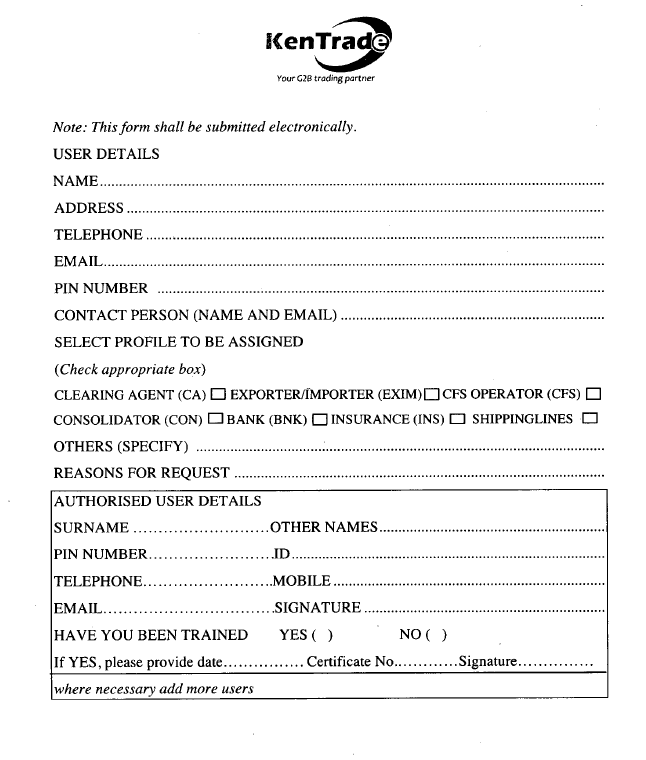
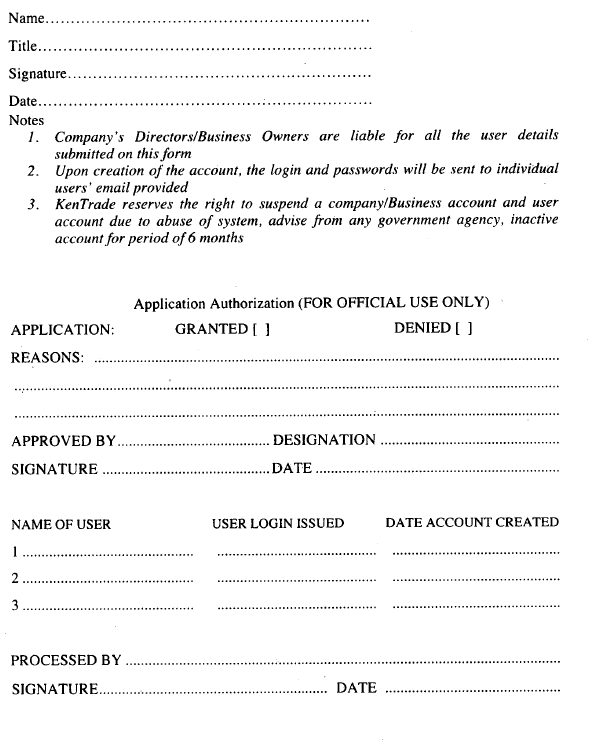
|
KTNA 2 :
|
APPLICATION FORM PARTNER GOVERNMENT AGENCY SYSTEM ACCESS
|
|
|
|
(r. 9(2)(a)(ii))
|
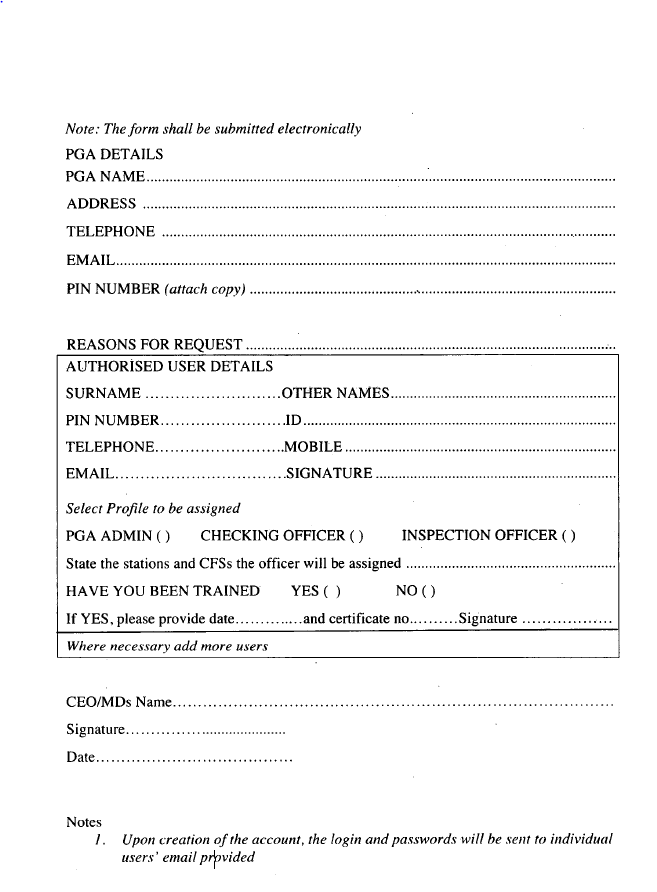
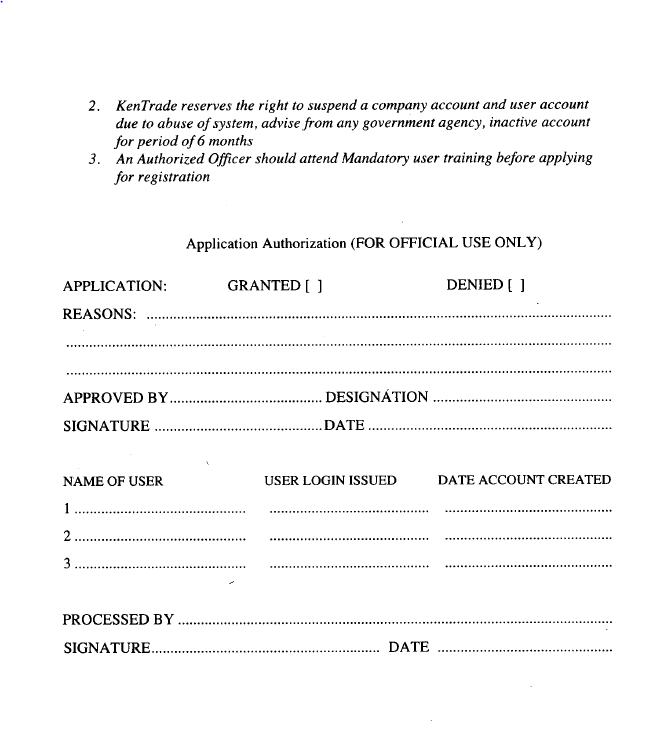
|
KTNA 3 :
|
USER ACCOUNT UPDATE FORM
|
|
|
|
(r. 13(3); r.15(1))
|
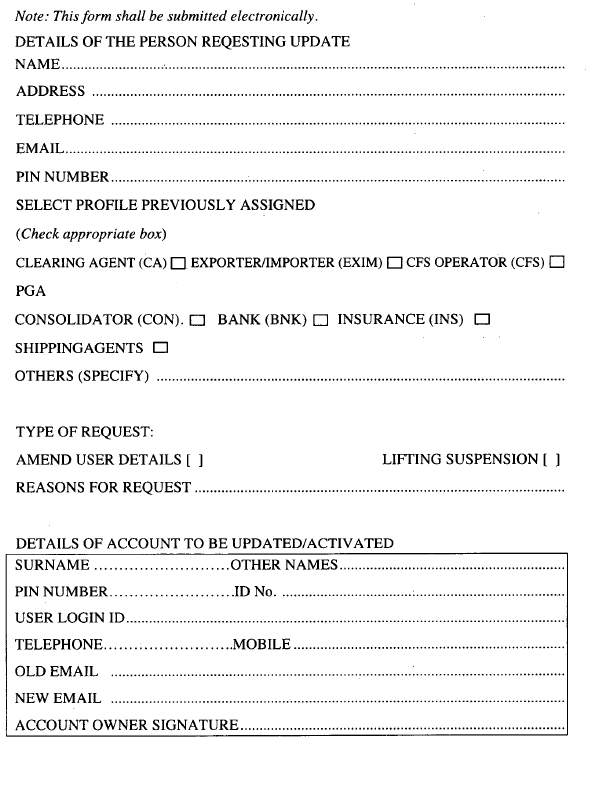
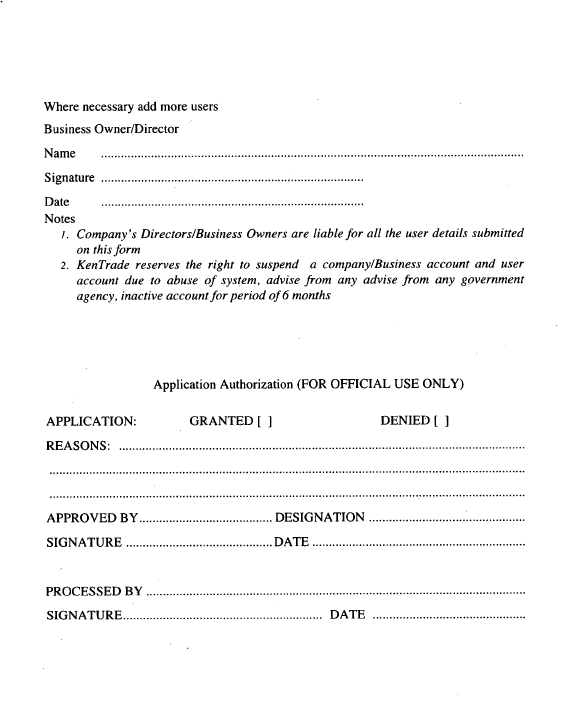
|
KTNA 4 :
|
COMPLAINT FORM
|
|
|
|
(r. 13(1))
|
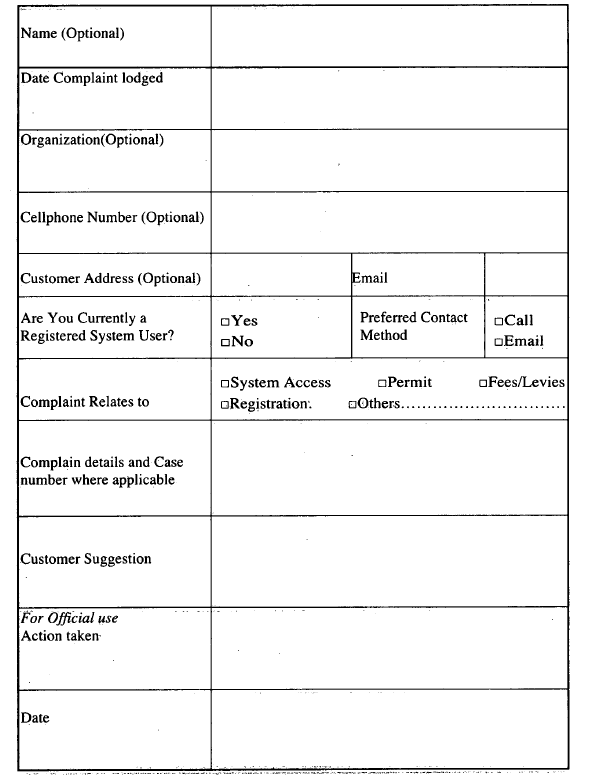
SECOND SCHEDULE [r. 9(2)(c), r. 13(3),r.15(2); r. 19(2)]
FEES
THIRD SCHEDULE [r. 13(1), r. 17(2)]
LEVELS OF ACCESS BY USERS
|










